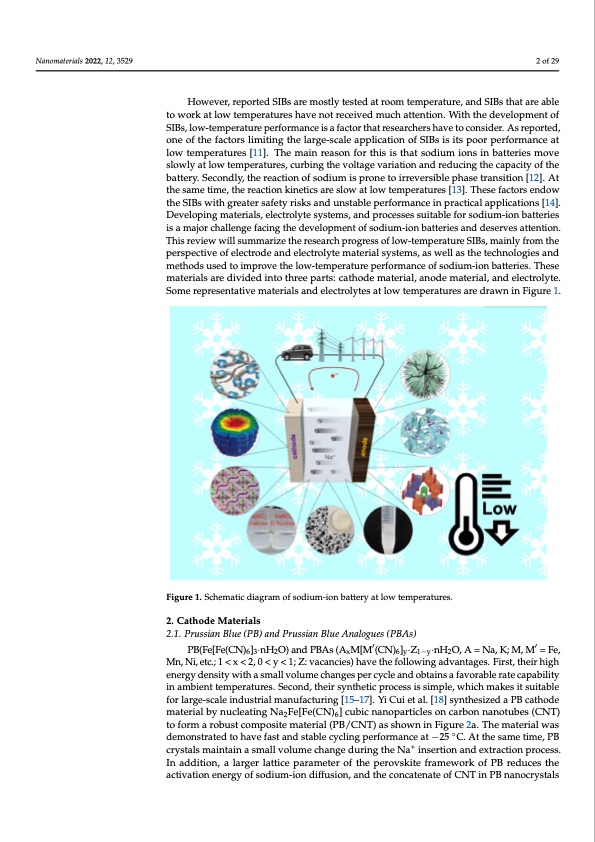
PDF Publication Title:
Text from PDF Page: 002
Nanomaterials 2022, 12, 3529 Nanomaterials 2022, 12, 3529 2 of 28 2 of 29 density of SIBs can exceed 100 W h/kg [9]. Moreover, the cost of electricity can reach less than 0.1/USD (W h) using SIBs [10]. However, reported SIBs are mostly tested at room temperature, and SIBs that are able However, reported SIBs are mostly tested at room temperature, and SIBs that are able to work at low temperatures have not received much attention. With the development of to work at low temperatures have not received much attention. With the development of SIBs, low-temperature performance is a factor that researchers have to consider. As re- SIBs, low-temperature performance is a factor that researchers have to consider. As reported, ported, one of the factors limiting the large-scale application of SIBs is its poor perfor- one of the factors limiting the large-scale application of SIBs is its poor performance at mance at low temperatures [11]. The main reason for this is that sodium ions in batteries low temperatures [11]. The main reason for this is that sodium ions in batteries move move slowly at low temperatures, curbing the voltage variation and reducing the capacity of the battery. Secondly, the reaction of sodium is prone to irreversible phase transition slowly at low temperatures, curbing the voltage variation and reducing the capacity of the battery. Secondly, the reaction of sodium is prone to irreversible phase transition [12]. At [12]. At the same time, the reaction kinetics are slow at low temperatures [13]. These fac- the same time, the reaction kinetics are slow at low temperatures [13]. These factors endow tors endow the SIBs with greater safety risks and unstable performance in practical appli- the SIBs with greater safety risks and unstable performance in practical applications [14]. cations [14]. Developing materials, electrolyte systems, and processes suitable for sodium- Dioenveblaotpteinrigesmisaatemrialjos,reclheacltlreonlgyetefascyisntgemthse, danevdeplorpomceesnsetsofsusoitdaibulme f-oiornsboadtituemrie-sioandbadtete-ries isearvmeasjoarttechntailolenn.gTehifsacrienvgietwhewdielvlesluompmaenritzoefthsoedrieusmea-ricohnpbraottgerreisesoafndlodwe-stemrvpeesrattuernetion. TShIiBssr,emviaeinwlywfirlolmsutmhempaerriszpeetchteivresoefaerlcehctprordogeraensdsoeflelcotwro-ltyetmepmeartaetruiarelsSyIsBtse,ms,aainslwyefrlloams the ptehresptecchtnivoeloogfiesleacntrdomdetahnodseluescetrdotloytiemmpraotevreiathl esylsotwem-tesm, apsewraetullreasptehrefotremchancoeloogfiesos-and mdeiuthmo-diosnubseadttetroieims.pTrhoevsetmhaetleorwial-steamrepderivaitdueredpinetrofotrhmreaenpcaerotsf:scoadthiuomde-imonatbearitatel,riaenso.dTehese maatteriials, anreddelievcitdreodlytien.toSotmhreereeparerstse:nctatihvoedmeamtearitaelrsialn,daneloedcteromlyattesriaatll,oawndteemlepcetrao-lyte. Stoumrees raerperdersaewntnaitnivFeigmuartee1ri.als and electrolytes at low temperatures are drawn in Figure 1. Figure 1. Schematic diagram of sodium-ion battery at low temperatures. Figure 1. Schematic diagram of sodium-ion battery at low temperatures. 2. Cathode Materials 2. Cathode Materials 2.1. Prussian Blue (PB) and Prussian Blue Analogues (PBAs) 2.1. Prussian Blue (PB) and Prussian Blue Analogues (PBAs) PB(Fe[Fe(CN)6]3·nH2O) and PBAs (AxM[Ḿ(′CN)6]y·Z1−y·nH2O, A = Na, K; M, Ḿ = F′e, PB(Fe[Fe(CN)6]3·nH2O)andPBAs(AxM[M(CN)6]y·Z1−y·nH2O,A=Na,K;M,M =Fe, Mn, Ni, etc.; 1 < x < 2, 0 < y < 1; Z: vacancies) have the following advantages. First, their Mn, Ni, etc.; 1 < x < 2, 0 < y < 1; Z: vacancies) have the following advantages. First, their high high energy density with a small volume changes per cycle and obtains a favorable rate energy density with a small volume changes per cycle and obtains a favorable rate capability capability in ambient temperatures. Second, their synthetic process is simple, which in ambient temperatures. Second, their synthetic process is simple, which makes it suitable makes it suitable for large-scale industrial manufacturing [15–17]. Yi Cui et al. [18] syn- for large-scale industrial manufacturing [15–17]. Yi Cui et al. [18] synthesized a PB cathode thesized a PB cathode material by nucleating Na2Fe[Fe(CN)6] cubic nanoparticles on car- material by nucleating Na2Fe[Fe(CN)6] cubic nanoparticles on carbon nanotubes (CNT) bon nanotubes (CNT) to form a robust composite material (PB/CNT) as shown in Figure to form a robust composite material (PB/CNT) as shown in Figure 2a. The material was demonstrated to have fast and stable cycling performance at −25 ◦C. At the same time, PB crystals maintain a small volume change during the Na+ insertion and extraction process. In addition, a larger lattice parameter of the perovskite framework of PB reduces the activation energy of sodium-ion diffusion, and the concatenate of CNT in PB nanocrystalsPDF Image | Na Ion Batteries Used at Low Temperatures

PDF Search Title:
Na Ion Batteries Used at Low TemperaturesOriginal File Name Searched:
nanomaterials-12-03529-v4.pdfDIY PDF Search: Google It | Yahoo | Bing
Salgenx Redox Flow Battery Technology: Salt water flow battery technology with low cost and great energy density that can be used for power storage and thermal storage. Let us de-risk your production using our license. Our aqueous flow battery is less cost than Tesla Megapack and available faster. Redox flow battery. No membrane needed like with Vanadium, or Bromine. Salgenx flow battery
| CONTACT TEL: 608-238-6001 Email: greg@salgenx.com | RSS | AMP |